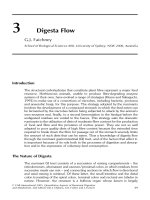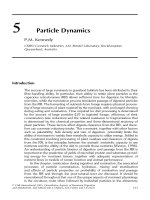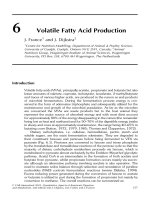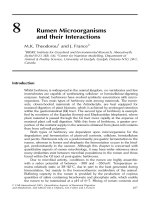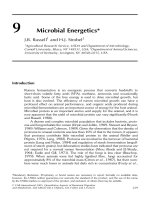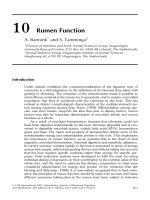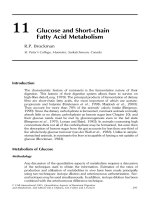In vivo aspects of potential stereospecific drug interactions of oral warfarin and rutin in rats
Bạn đang xem bản rút gọn của tài liệu. Xem và tải ngay bản đầy đủ của tài liệu tại đây (539.5 KB, 134 trang )
IN VIVO ASPECTS OF POTENTIAL STEREOSPECIFIC
DRUG INTERACTIONS OF ORAL WARFARIN AND
RUTIN IN RATS
AKHIL KUMAR HEGDE R. (M.PHARM)
A THESIS SUBMITTED FOR THE DEGREE OF
MASTER OF SCIENCE (PHARMACY)
DEPARTMENT OF PHARMACY
NATIONAL UNIVERSITY OF SINGAPORE
2005
Dedicated to two of my most special friends who have made this possible for me,
Vishwa and Napsiah
i
ACKNOWLEDGEMENTS
I would like to thank my supervisor, A/P Eli Chan, Associate Professor, Dept. of
Pharmacy, NUS for his support, supervision, guidance and training throughout the
project. It was my privilege to carry out this work under the able guidance of Prof.
Chan. With his rich experience and profound knowledge in Pharmacokinetics, he
helped me design, execute and analyze the data of this project. He also helped me
immensely in preparing this dissertation with his valuable insights and vision. My
sincere gratitude to A/P Eli Chan.
I am grateful to the National University of Singapore for providing generous
Research Fund and facilities for this work.
I was fortunate to have the assistance and encouragement of many people in the
department. A few among them deserve special mention.
I express my deep sense of gratitude to Dr. Koh Hwee Ling, Asst. Prof., Dept. of
Pharmacy, NUS, for allowing me to use the equipments and facilities in her lab. Also,
I am indebted to her for her continuous encouragement, untiring patience, valuable
suggestions, personal attention and concern. I also extend my sincere thanks to Dr.
Seetharama Jois, Asst. Prof., Dept. of Pharmacy, NUS, who was always there for
me when I needed moral support, encouragement and help.
Words cannot express my heartfelt gratitude for the constant support and encouraging
ii
words of Assoc. Prof. Go Mei Lin, Assoc. Prof. Paul Ho, Assoc. Prof.
Chan Sui Yung, Assoc. Prof. Lim Lee Yong, Assoc. Prof. Chan Lai Wah
and Dr Shanthi. I want to acknowledge that I hold all of them in my highest regards
both professionally and personally.
My special thanks to all the non-academic staff of the Dept. of Pharmacy, NUS. I
would like to especially thank Mrs. Teo Say Moi, Ms Napsiah Bte Suyod, Ms.
Ng Swee Eng, Mr. Tang Chong Wing, Ms. Wong Mei Yin, Ms. Ng Sek
Eng, Ms. Oh Tang Booy, Ms. Lee Hua Yeong and Ms. Lim Sing for all
their help and assistance.
My heartfelt thanks to all my friends and colleagues in the dept. especially Wai Ping,
Qingyu, Xiaofang, Anand, Yulan, Li Jing, Collin, Su Jie, Ma Xiang, Zheng Lin, Mo
Yun, Chen Xin, Xiaoqiang, Aik Jiang, Zeping and Xiaoxia whose love and support
made my time in the dept. pleasant and memorable.
Last but not least, I would like to thank my dearly loved ones for their blessings and
love throughout my graduate studies. It was the love, understanding and support of
my family that has always inspired me to reach higher and persevere through the
toughest times.
iii
TABLE OF CONTENTS
ACKNOWLEDGEMENTS
ii
TABLE OF CONTENTS
iv
SUMMARY
viii
LIST OF TABLES
x
LIST OF FIGURES
xii
ABBREVIATIONS
xiv
CHAPTER 1:
INTRODUCTION
1.1. LITERATURE REVIEW
1
3
1.1.1. HISTORICAL PERSPECTIVE OF WARFARIN
3
1.1.2. CHEMISTRY
5
1.1.3. PHARMACODYNAMICS
5
1.1.3.1. MECHANISAM OF ACTION
5
1.1.4. PHARMACOKINETICS
7
1.1.4.1. ABSORPTION
7
1.1.4.2. DISTRIBUTION
9
1.1.4.3. METABOLISM AND EXCRETION
11
1.1.5. MEASUREMENT OF ANTICOAGULATION
17
1.1.6. CHEMICAL ANALYSIS
19
iv
1.1.7. WARFARIN DRUG INTERACTIONS
1.1.7.1. WARFARIN INTERACTIONS WITH
20
24
COMPLEMENTARY AND ALTERNATIVE
MEDICINES (CAM)
1.1.8. FLAVONOIDS
27
1.1.8.1. INTRODUCTION
27
1.1.8.2. RUTIN AND QUERCETIN
29
CHAPTER 2:
OBJECTIVES
38
CHAPTER 3:
IN VIVO SINGLE DOSE STUDY
39
3.1. INTRODUCTION
39
3.2. OBJECTIVES
39
3.3. MATERIALS AND METHODS
40
3.3.1. CHEMICAL AND REAGENTS
40
3.3.2. APPARATUS
41
3.3.3. ANIMALS AND SAMPLING METHOD
42
3.3.3.1. PREPARATION OF CITRATE BUFFER-
42
DILUTED PLASMA
3.3.4. CHEMICAL ANALYSIS
44
3.3.5. ESTIMATION OF ANTICOAGULATION
44
3.3.6. ANIMAL STUDY PROTOCOL
44
3.3.7. DATA ANALYSIS
45
3.3.7.1. PHARMACODYNAMIC ANALYSIS
45
3.3.7.2. PHARMACOKINETIC ANALYSIS
46
v
3.3.7.3. STATISTICAL ANALYSIS
46
47
3.4. RESULTS
3.4.1. WARFARIN PHARMACOKINETICS
47
3.4.2. EFFECT OF RUTIN TREATMENT ON WARFARIN
52
ANTICOAGULATION
3.5. DISCUSSION
52
3.6. CONCLUSION
58
CHAPTER 4:
IN VIVO MULTIPLE DOSE STUDY
60
4.1. INTRODUCTION
60
4.2. OBJECTIVES
63
4.3. MATERIALS AND METHODS
64
4.3.1. APPARATUS
64
4.3.2. ANIMALS AND SAMPLING METHOD
65
4.3.2.1. PREPARATION OF CITRATE BUFFER-
65
DILUTED PLASMA
4.3.3. CHEMICAL ANALYSIS
65
4.3.4. ESTIMATION OF ANTICOAGULATION
66
4.3.5. ANIMAL STUDY PROTOCOL
66
4.3.5.1. MULTIPLE DOSE STUDY
66
4.3.5.2. CONTROL RUTIN TREATMENT STUDY
67
IN THE ABSENCE OF WARFARIN
4.3.6. DATA ANALYSIS
67
4.3.6.1. PHARMACODYNAMIC ANALYSIS
67
4.3.6.2. PHARMACOKINETIC ANALYSIS
68
vi
4.3.6.3. STATISTICAL ANALYSIS
69
69
4.4. RESULTS
4.4.1. STEADY STATE PHARMACOKINETICS OF WARFARIN
69
4.4.2. EFFECT OF RUTIN TREATMENT ON WARFARIN
73
ANTICOAGULATION AT STEADY STATE
4.4.3. EFFECT OF RUTIN TREATMENT ALONE
75
ON BLOOD COAGULATION
4.5. DISCUSSION
75
4.6. CONCLUSION
83
CHAPTER 5:
CONCLUSION
85
CHAPTER 6:
POTENTIAL APPLICATIONS AND
87
SUGGESTIONS FOR FUTURE WORK
6.1. POTENTIAL APPLICATIONS
87
6.2. SUGGESTIONS FOR FUTURE WORK
88
BIBLIOGRAPHY
90
APPENDIX
108
PRESENTATION:
1. Poster presentation at “2nd Asia-Pacific Conference and Exhibition on Anti-Ageing
Medicine 2003”, Singapore.
2. Poster presentation at “17th PSS Congress and the Intervarsity Symposium 2005”,
Singapore.
vii
SUMMARY
Polypharmacy is prevalent among most of the therapeutic regimens to treat patients.
Approximately one third of adults in the United States take complementary and
alternative medicines (CAM) (1). Interactions between these drugs may affect the
pharmacological or adverse effects of each other and complicate the management of
long-term drug therapies.
Numerous drug interactions are observed with oral anticoagulant warfarin. The effects
of warfarin are highly sensitive to the co-administered drugs. Warfarin therapy is
complicated by the fact that it has a narrow therapeutic index and its enantiomers vary
in pharmacokinetic and pharmacodynamic properties. Flavonoids are known to affect
the bioavailability of drugs through cytochrome P450 modulation (2, 3, 4, 5, 6).
Rutin, a flavonoid glycoside, and its aglycone quercetin are abundant in nature,
especially in fruits and vegetables. Rutin is also widely found as a constituent of
multivitamin preparations and herbal remedies. The present study was designed to
investigate the potential drug interactions between rutin and warfarin in rats.
In the single dose study, rats pretreated for four days with oral rutin (1 g in 1% CMcellulose/kg) or an equal volume (5 ml/kg) of 1% CM-cellulose (as the control), were
given a single dose of racemic warfarin (1.5 mg/kg) orally. With the rutin regimen
continued, blood samples were collected at different intervals over 96 h. In the
multiple dose study, rats pretreated for five days with oral warfarin (0.15 mg/kg/day)
to attain steady state, were given rutin (1 g in 1% CM-cellulose/kg) or an equal
volume (5 ml/kg) of 1% CM-cellulose (as the control) orally along with the daily
viii
warfarin for another six days. Blood samples were collected at different intervals over
168 h. The S- and R- enantiomers of warfarin in serum were separated and analyzed
by high performance liquid chromatography. Plasma prothrombin time was measured.
With the single dose of warfarin, hypoprothrombinaemia, as measured by reduced
percentage of normal prothrombin complex activity, was observed in both rutin
treated and control rats, but the recovery was found to be much faster in rutin
treatment group compared to control animals. Of both S- and R- warfarin, the
maximum serum concentration values, were increased, while the elimination half-life
and apparent volume of distribution values, were significantly reduced with rutin
treatment. There was an apparent increase in the rate of absorption and decrease in the
time to reach peak serum concentration of both the enantiomers, though not
statistically significant. With multiple doses of warfarin, rutin treatment resulted in
higher percentage of normal prothrombin complex activity compared to control. Both
rutin treated and control animals showed steady state serum levels of S- and Rwarfarin with lower values of S- warfarin in the former group. Rutin treatment
showed a trend to increase the steady state clearance, reduce the volume of
distribution and elimination half-life, of S- warfarin.
These results indicate a potential interaction between rutin and warfarin. As rutin and
quercetin are present in numerous diets of plant origin, precaution must be taken
before starting warfarin therapy in subjects who are on a diet rich in these
bioflavonoids.
ix
LIST OF TABLES
TABLE
DESCRIPTION
PAGE
1.1
Indications for warfarin therapy
4
1.2
Pharmacokinetic parameters, estimated in rats after
oral ingestion of single and multiple doses of warfarin
10
1.3
Apparent binding and tissue-serum partition constants
for S-warfarin in rat tissues
12
1.4
Comparison of reported pharmacokinetic parameters
of warfarin elimination in different animal species
15
1.5
Warfarin drug interactions
23
1.6
Warfarin interactions with herbs and herbal products
26
1.7
Drug information: Rutin
30
1.8
Pharmacokinetic parameters of oral quercetin and rutin
in human plasma
33
1.9
Pharmacokinetic variables of absorption and elimination
of quercetin from various foods/sources in human plasma
34
1.10
Total area under plasma concentration-time curve
(AUC0-24) and mean (± S.E) 24 h urinary excretion of
quercetin and methylated quercetin in rats administered
quercetin and rutin
35
1.11
On-line resources for herbal product interaction
with warfarin
37
3.1
Estimated pharmacokinetic parameters of (S)- and (R)-
51
x
enantiomers of warfarin after a single oral
administration of racemic drug (1.5 mg/kg) to rats
in the absence and presence of rutin
3.2
Estimated pharmacodynamic parameters (mean± S.D.)
following a single oral administration of racemic
warfarin (1.5 mg/kg) to rats alone (control) and
during rutin treatment
53
4.1
Clinical case reports of complications arising due to
interactions between multiple warfarin dosing and herbs
62
4.2
Pharmacokinetic parameters of control (treated with
CM-cellulose only) and rutin treated (rutin in
CM-cellulose) rats with respect to S- and R- warfarin
after treatment with multiple doses of racemic warfarin
(0.15 mg/kg body weight/day) orally
74
4.3
Pharmacodynamic parameters of control (treated with
CM-cellulose only) and rutin treated (rutin in
CM-cellulose) rats after treatment with multiple doses
of racemic warfarin (0.15 mg/kg body weight/day) orally
77
xi
LIST OF FIGURES
FIGURE
DESCRIPTION
PAGE
1.1
Warfarin chemical structure
6
1.2
Mechanism of warfarin anticoagulation
8
1.3
Physiologically based pharmacokinetic model
for (S)-warfarin disposition in rats
18
1.4
Schematic instrumental setup for chiral
separation of warfarin enantiomers by HPLC
21
1.5
Chemical structures of flavonols, quercetin and
rutin
28
3.1
Time courses of total serum concentrations
(mean ± S.D.) of S- and R- enantiomers of
warfarin following a single oral administration
of racemic dose (1.5 mg/kg) to rats alone
(receiving 1% CM-cellulose, 5 ml/kg daily,
as the control) and during 8-day treatment with
rutin (1 g in 1% CM-cellulose, 5 ml/kg daily)
48
3.2
S- warfarin (mean) curve fitting for (a) control
and (b) rutin treated rats in single dose study
using WinNonlin
49
3.3
R- warfarin (mean) curve fitting for (a) control
and (b) rutin treated rats in single dose study
using WinNonlin
50
3.4
Changes in prothrombin time (PT in s) and
prothrombin complex activity (PCA in percent
of normal) with time following a single oral dose
of racemic warfarin (1.5 mg/kg) to rats treated
with and without rutin.
54
xii
4.1
Time profiles of S- and R- warfarin concentrations
(mean ± S.D.) in serum after multiple oral doses of
racemic warfarin (0.15 mg/kg body weight) in control
(CM-cellulose alone) and rutin treated rats (n = 6)
70
4.2
Mean S- warfarin curve fitting for (a) control and
(b) rutin treated rats using WinNonlin
71
4.3
Mean R- warfarin curve fitting for (a) control and
(b) rutin treated rats using WinNonlin
72
4.4
Changes in prothrombin time (PT), (s) and
prothrombin complex activity (PCA), (percent of
normal) with time following multiple oral doses
of racemic warfarin (0.15 mg/kg body weight)
in control (CM-cellulose alone) and rutin
(1 g/kg body weight) treated rats.
76
4.5
Changes in prothrombin time (PT), (s) and
prothrombin complex activity (PCA), (percent of
normal) with time in rats treated with and without
(control) rutin (1 g/kg body weight).
78
xiii
ABBREVIATIONS
AUC, total area under the serum concentration-time curve; Cmax, maximum (peak)
serum concentration; tmax, peak time; CL, total serum clearance; CM-Cellulose,
carboxy methyl cellulose; CYP, cytochrome P-450; ka, absorption rate constant;
PCA, prothrombin complex activity; PCAmin, minimum value of PCA; tPCA,min, time to
achieve PCAmin; PCA AUC0-96, total area under the PCA–time curve from time zero to
96 h; PT, prothrombin time; PT0, basal mean prothrombin time; t1/2, elimination halflife; Vd, apparent volume of distribution.
xiv
CHAPTER 1 INTRODUCTION
Warfarin, a coumarin oral anticoagulant, is frequently used for the treatment and
prevention of thromboembolic diseases. Racemate warfarin (mixture of R- and Senantiomers) is normally used in clinical practice. S-warfarin is approximately five
times more active than the R- isomer (7, 8) and is responsible for essentially all of the
anticoagulant effects of the drug. It is also found to be more prone to drug
interactions. Warfarin is highly bound to plasma protein (97.4-99%), especially
albumin (8, 9). Given orally, warfarin is completely absorbed (10) and is metabolized
by hepatic CYPs (11). S-Warfarin is metabolized by CYP2C9 to S-7-hydroxywarfarin
in humans (11, 12), whereas R-warfarin is mainly oxidized to R-6-hydroxywarfarin,
primarily by CYP1A2 and CYP3A4 (11, 12). Warfarin is a low extraction ratio drug
(10).
Flavonoids, an important family of antioxidants, are ubiquitous in edible plants, fruits,
foods and medicinal botanicals (13, 14, 15). Flavonoids are known to affect the
bioavailability of drugs through cytochrome P-450 (CYP) (15) and/or P-glycoprotein
modulation (2, 3, 4, 5, 16). In general they occur in food as glycosides (4, 14). Rutin
is a flavonoid glycoside abundant in the plant kingdom (14). Rutin derivatives (e.g.
oxerutin and troxerutin) are used to treat various cardiovascular conditions (17, 18,
19). Reports have shown its usefulness in treating abnormal fragility of the capillaries
and as a vasoprotectant (20, 21, 22). Rutin is also reported to relieve venous
insufficiency of the lower limbs and capillary impairment (18, 19). Rutin and its
derivatives have been combined with oral anticoagulant such as warfarin in
cardiovascular patients (23). Therefore, it could directly or indirectly influence some
1
of the metabolic pathways and thus affect the pharmacological actions of the coadministered drug.
Quercetin, the aglycone of rutin (24), meets the structural requirements for a strong
antioxidant (24). Both quercetin and rutin form an integral part of various nutritional
supplements and herbal preparations (25). Estimated average intake of quercetin in
the USA is 20-22 mg per day (26). Consumption of rutin or quercetin diet resulted in
the same conjugated metabolites in rat (14), pig (27) and human plasma (25, 28).
Quercetin binds strongly to human serum albumin (HSA) (up to 99.1-99.4 ± 0.5 %) in
vitro (24). When administered for a long time, quercetin accumulates in the blood and
this could be attributed to its long elimination half-life (29). Quercetin has been
shown to inhibit CYP3A4 enzymes in human microsomes in vitro (30), the enzyme
responsible for the metabolism of R- enantiomer of warfarin. It also modulates Pglycoprotein, a plasma membrane transporter (13).
The present study was carried out to explore the pharmacokinetic and
pharmacodynamic interactions of warfarin with rutin in rats, since warfarin is a
commonly used oral anticoagulant (31) with wide variation in dose-response (32) and
narrow therapeutic index and rutin is present in most of the foods, vegetables and
dietary supplements. A retrospective clinical study has shown that patients with
severe nonreconstructable chronic critical leg ischemia benefited from initial therapy
with intravenous rutin combined with long-term oral warfarin treatment (23). To our
knowledge, there have been no studies on the interactions between warfarin and rutin
in rats. Thus, it was imperative to study the potential interactions between the two
compounds.
2
1.1. LITERATURE REVIEW
Warfarin is one of the most frequently used anticoagulants for the treatment and
prevention of thromboembolic diseases. It has the advantage over heparin as it can be
administered orally in long-term therapy. With low costs, it turns out to be
economical to patients if taken for years. Some of the indications for warfarin therapy
are listed out in Table 1.1.
1.1.1. HISTORICAL PERSPECTIVE OF WARFARIN
Oral anticoagulants were discovered accidentally in the 1920s when livestock in
North Dakota fed decomposed sweet clover developed bleeding disorder (33, 34). The
animals were progressively unable to form clots and bled to death after 30 days of
ingestion. The disorder was reversible when the clover was removed from the feed or
when the animals were transfused with fresh blood from unaffected animals. Vitamin
K administration also reversed the condition. In 1934, bishydroxycoumarin
(dicoumarol) was isolated and identified as the cause of the disorder. Warfarin, a
coumarin derivative, was synthesized in 1944 and used as a highly effective rat poison
initially. In 1951, an army inductee survived a suicide attempt after ingesting 567mg
of warfarin (34). The hemorrhage was reversed by administering vitamin K and blood
transfusion. This led to the widespread use of warfarin in clinics as an effective
anticoagulant with vitamin K as an antidote if bleeding complications arose.
3
Table 1.1 Indications for warfarin therapy
Treatment
Target INR/
Reference
treatment
Prophylactic therapy
Target INR/
in patients
treatment
duration
Deep venous
2-3 / 3 months
Reference
duration
61
thrombosis
Prosthetic heart
2-3.5-4.5
valves
(3-12 months/
128
long-term)
Pulmonary
2-3 / 3 months
61
embolism
Arterial
Stents, filter devices,
2.5-3.5/
indwelling catheters
lifelong
37
>3 / long-term
37
in blood vessels
2-3
37
Atrial fibrillation
2-3 / long-term
129
2-3
37
Myocardial infarction
2-3 / long-term
37
vascular
Valvular heart
2-3 / long-term
130
disease
diseases
Post-surgery or
1.6-2.3 / 4-6
61
immobilization
weeks
Thromboses
Unstable
angina
Peripheral
Certain renal
-
37
diseases
Small cell
-
37
Recurrent
2-2.85/ long-
131
venous
term
(low dose)
lung cancer
Antiphospholipid
3-4 / lifelong
34
34
syndrome
thrombo-
Antithrombin
3-6 months or
embolism
deficiency
long-term
and Factor V Leiden
mutation
4
1.1.2. CHEMISTRY
Warfarin [3-(α-acetonylbenzyl)-4-hydroxy coumarin] is a single-ring coumarin
derivative (8) (Fig. 1.1). It is weakly acidic (pKa 5.1) (35), insoluble in water and
shows natural fluorescence with excitation at 290-342 nm and emission at 385 nm
(36). The 4-hydroxycoumarin residue of warfarin with a nonpolar carbon substituent
at the 3-position (asymmetrical carbon), is required for the pharmacodynamic
properties (37). The 4-hydroxycoumarin ring binds to the reductase receptor. The side
chain affects the disposition and metabolism of warfarin. Clinically warfarin is
available as a racemic mixture of (R)- and (S)- enantiomers.
1.1.3. PHARMACODYNAMICS
1.1.3.1. Mechanism of action
Vitamin K is an important cofactor for the enzymatic pathway of blood coagulation. It
is essential for the γ-carboxylation of glutamate residues on inactive forms of clotting
factors to γ-carboxyglutamic acid (8, 34, 38, 39, 40, 41, 42, 43). γ-carboxylation
permits these coagulation proteins to undergo a conformational change in the
presence of calcium ions (43, 44). In the absence of γ-carboxylation clotting factors
are unable to bind to calcium ions and phospholipid surfaces through calcium ion
bridges (8, 34) and have reduced activity.
Warfarin acts as an anticoagulant by reducing the synthesis of the vitamin Kdependent clotting factors like factor II, VII, IX and X and thus decreases the risk of
thrombosis (45, 46). The mechanism is not completely understood but involves
5
(S)-warfarin
O
OH
H
O
O
(R)-warfarin
O
OH
H
O
O
Figure 1.1 Warfarin chemical structure
6
inhibition of vitamin K reductase enzyme (Fig. 1.2), which is responsible for
converting inactive vitamin K epoxide to active vitamin K (38, 39, 47). Thus warfarin
blocks the regeneration of the active form of vitamin K and does so in a dosedependent manner. The time to deplete vitamin K to a threshold level so as to affect
the synthesis of clotting factors is responsible for the delay in onset of action after the
warfarin dose (8). Vitamin K stores in liver are eventually depleted. The anticoagulant
response to warfarin is unpredictable and requires a careful monitoring for potential
interactions. Age, diet, illness, patient compliance, genetic factors, physical activity,
concurrent drug therapy and other unknown factors can affect the response to
warfarin.
1.1.4. PHARMACOKINETICS
Warfarin is a drug of choice for the pharmacokinetic modeling. It has a reliable onset
and duration of action and good bioavailability. (S)-warfarin is approximately five
times more potent (7, 8) and is metabolized more rapidly than the (R)- isomer in man
(8, 48). The concentration of each isomer in plasma therefore varies within and
among patients. (S)- isomer is responsible for essentially all of the anticoagulant
response of the drug and is found to be more prone to drug interactions.
1.1.4.1. Absorption
Warfarin is absorbed rapidly and almost completely when administered orally (8).
The bioavailability of racemic warfarin solutions is almost complete also when
administered intramuscularly, rectally or intravenously (37). It is detectable in plasma
7
Reduced Vitamin K
Warfarin
OH
CH3
R
Prothrombin
precursor
OH
Vitamin K
reductase
O
O2
CH3
CO2
Carboxylase
R
O
Vitamin K
Prothrombin
Warfarin
O
CH3
O
Vitamin K epoxide
reductase
R
O
Oxidised Vitamin K
Figure 1.2 Mechanism of warfarin anticoagulation
Warfarin acts as an anticoagulant by reducing the synthesis of the vitamin Kdependent clotting factors. Its anticoagulant effects are achieved by interfering with
cyclic interconversion of Vitamin K via inhibition of vitamin K reductase enzyme,
which is responsible for converting inactive vitamin K epoxide to active vitamin K.
Thus warfarin blocks the regeneration of the active form of vitamin K
8
within 1 hour of its oral absorption (37). Peak blood concentration is reached within
90 minutes (range between 2 to 8 hours) (37). The rate of absorption is delayed by the
presence of food but the bioavailability is not affected. Table 1.2 shows various
pharmacokinetic parameters, estimated in rats after oral ingestion of single and
multiple doses of warfarin (49).
1.1.4.2. Distribution
The volume of distribution of racemic warfarin in man is found to be 0.09-0.17 L/kg
(8). Warfarin is highly bound (97.4-99.9 %) to plasma proteins, mainly albumin. The
relative serum protein binding of warfarin is independent of concentration over a
broad range (50). Bound warfarin lacks its activity and is protected from
biotransformation and excretion (8). The protein binding affinity differs between the
two enantiomers of warfarin. The S- isomer has a greater affinity to protein binding in
man compared to the R- isomer. Some of the drug interactions of warfarin by protein
binding displacement may involve only one of the two enantiomers. Thus, highly
protein bound acidic drugs can displace warfarin stereospecifically from the binding
sites (8). Such interactions may be clinically significant, but may go undetected if
only the racemate warfarin concentration is measured. However displacement from
protein binding sites may cause only transient increase in the concentration of
unbound warfarin as the total body clearance is increased with more unbound drug
available at the elimination sites (8).
Tissue binding of warfarin involves two classes of binding sites, one with high
affinity and low capacity and the other with lower affinity and unlimited capacity (50)
9
Table 1.2 Pharmacokinetic parameters estimated in rats after oral ingestion of
single and multiple doses of warfarin (49)
Parameters
Warfarin (oral)
Single dose (2 mg/kg)
Multiple doses (0.2 mg/kg/day,
for 6 days)
Cmax (µg/ml)
7.8 ± 0.5
9.4 ± 1.4
tmax (h)
2.6 ± 1.0
2.0 ± 0.0
AUCa (mg.h/ml)
118 ± 22
133 ± 10
t1/2 (h)
14.3 ± 5.8
16.3 ± 3.0
Vd (ml/kg)
1483 ± 746
1419 ± 294
CL (ml/h)
17.5 ± 3.3
15.0 ±1.0
Values are mean ± S.D. (n = 6)
Cmax, maximum plasma concentration; tmax, peak time; AUC, total area under plasma
concentration-time curve; t1/2, elimination half life; Vd, apparent volume of
distribution; CL, total plasma clearance; PT0, basal prothrombin time at time zero;
PTmax, maximal PT achieved; Tmax,PT time to PTmax;
a
AUC0-∞ and AUC0-τ for single and multiple dose study, respectively.
10


